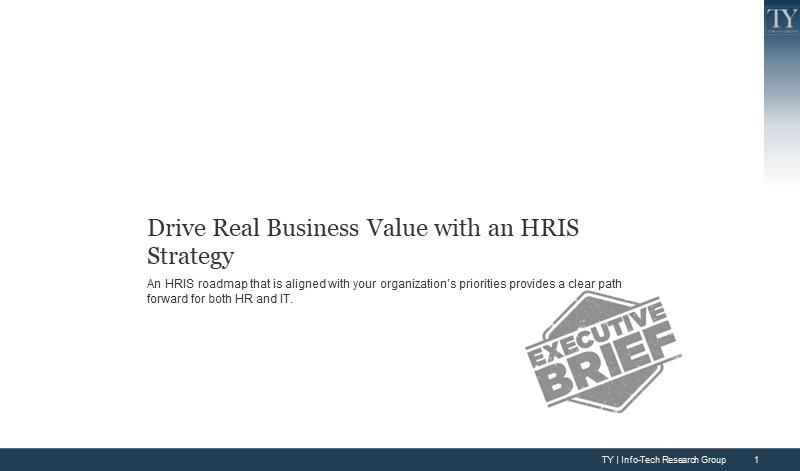
Drive Real Business Value with an HRIS Strategy
- In most organizations, the HR application portfolio has evolved tactically on an as-needed basis, resulting in un-integrated systems and significant effort spent on manual workarounds.
- The relationship between HR and IT is not optimal for technology decision making. System-related decisions are made by HR and IT is typically involved only post-purchase to fix issues as they arise and offer workarounds.
- IT systems for HR are not viewed as a strategic differentiator or business enabler, thereby leading to a limited budget and resources for HR IT systems and subsequently hindering the adoption of a strategic, holistic perspective.
- Some organizations overinvest, while others underinvest in lightweight, point-to-point solutions. Finding the sweet spot between a full suite and lightweight functionality is no easy task.
Our Advice
Critical Insight
- Align HRIS goals with the business. Organizations must position HR as a partner prior to embarking on an HRIS initiative, aligning technology goals with organizational objectives before looking at software.
- Communication is key. Often, HR and IT speak different languages. Maintain a high degree of communication by engaging stakeholder groups early.
- Plan where you want to go. Designing a roadmap based on clear requirements, alignment with the business, and an understanding of priorities will contribute to success.
Impact and Result
- Evaluate the current state of HRIS, understand the pain points, and visualize your ideal processes prior to choosing a solution.
- Explore the different solution alternatives: maintain current system, integrate and consolidate, augment, or replace system entirely.
- Create a plan to engage IT and HR throughout the project. Equip HR with the decision-making tools to meet business objectives and drive business strategy. Establish a common language for IT and HR to effectively communicate.
- Develop a practical and actionable roadmap that the entire organization can buy into.
Drive Real Business Value with an HRIS Strategy Research & Tools
Start here – read the Executive Brief
Read our concise Executive Brief to find out why you should develop an HRIS strategy, review Info-Tech’s methodology, and understand the four ways we can support you in completing this project.Besides the small introduction, subscribers and consulting clients within this management domain have access to:
- Drive Real Business Value with an HRIS Strategy – Phases 1-3
- HRIS Strategy & Roadmap for Local Government
1. Conduct an environmental scan
Create a clear project vision that outlines the goals and objectives for the HRIS strategy. Subsequently, construct an HRIS business model that is informed by enablers, barriers, and the organizational, IT, and HR needs.
- Drive Real Business Value with an HRIS Strategy – Phase 1: Conduct an Environmental Scan
- Establish an HRIS Strategy Project Charter Template
- HRIS Readiness Assessment Checklist
2. Design the future state
Gather high-level requirements to determine the ideal future state. Explore solution alternatives and choose the path that is best aligned with the organization's needs.
- Drive Real Business Value with an HRIS Strategy – Phase 2: Design the Future State
- HRIS Strategy Stakeholder Interview Guide
- Process Owner Assignment Guide
3. Finalize the roadmap
Identify roadmap initiatives. Prioritize initiatives based on importance and effort.
- Drive Real Business Value with an HRIS Strategy – Phase 3: Finalize the Roadmap
- Initiative Roadmap Tool
- HRIS Stakeholder Presentation Template
Workshop: Drive Real Business Value with an HRIS Strategy
Workshops offer an easy way to accelerate your project. If you are unable to do the project yourself, and a Guided Implementation isn't enough, we offer low-cost delivery of our project workshops. We take you through every phase of your project and ensure that you have a roadmap in place to complete your project successfully.
1 Conduct an Environmental Scan
The Purpose
Understand the importance of creating an HRIS strategy before proceeding with software selection and implementation.
Learn why a large percentage of HRIS projects fail and how to avoid common mistakes.
Set expectations for the HRIS strategy and understand Info-Tech’s HRIS methodology.
Complete a project charter to gain buy-in, build a project team, and track project success.
Key Benefits Achieved
A go/no-go decision on the project appropriateness.
Project stakeholders identified.
Project team created with defined roles and responsibilities.
Finalized project charter to gain buy-in.
Activities
1.1 Set a direction for the project by clarifying the focus.
1.2 Identify the right stakeholders for your project team.
1.3 Identify HRIS needs, barriers, and enablers.
1.4 Map the current state of your HRIS.
1.5 Align your business goals with your HR goals and objectives.
Outputs
Project vision
Defined project roles and responsibilities
Completed HRIS business model
Completed current state map and thorough understanding of the HR technology landscape
Strategy alignment between HR and the business
2 Design the Future State
The Purpose
Gain a thorough understanding of the HRIS-related pains felt throughout the organization.
Use stakeholder-identified pains to directly inform the HRIS strategy and long-term solution.
Visualize your ideal processes and realize the art of the possible.
Key Benefits Achieved
Requirements to strengthen the business case and inform the strategy.
The art of the possible.
Activities
2.1 Requirements gathering.
2.2 Sketch ideal future state processes.
2.3 Establish process owners.
2.4 Determine guiding principles.
2.5 Identify metrics.
Outputs
Pain points classified by data, people, process, and technology
Ideal future process vision
Assigned process owners, guiding principles, and metrics for each HR process in scope
3 Create Roadmap and Finalize Deliverable
The Purpose
Brainstorm and prioritize short- and long-term HRIS tasks.
Key Benefits Achieved
Understand next steps for the HRIS project.
Activities
3.1 Create a high-level implementation plan that shows dependencies.
3.2 Identify risks and mitigation efforts.
3.3 Finalize stakeholder presentation.
Outputs
Completed implementation plan
Completed risk management plan
HRIS stakeholder presentation